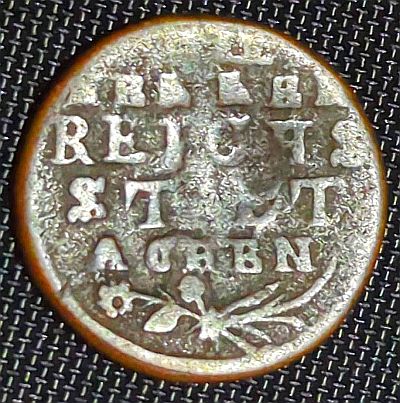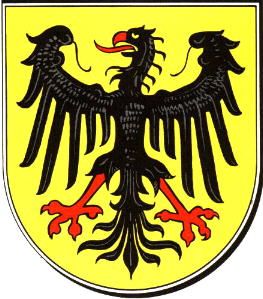Aachen today, is a city in western Germany, on the border with both Belgium and the Netherlands. Aachen is famous for its spas, it’s cathedral and as the burial place of Charlemagne. In 1794, Aachen issued this 12 Heller coin:

The coin is somewhat worn, and the top line is almost completely missing. It should read:
XII
HELLER
REICHS
STADT
ACHEN
Which translates to “12 Heller, Imperial city Achen”, and that raises a few questions. Firstly, what is an “Imperial city”? The full title is “Free imperial city“. It is a city which comes under the authority of the Holy Roman Emperor, rather than a territorial Lord. Let’s step back a bit. Aachen has been settled since at least 3,000 BC, and particularly prized for its hot sulphur springs. The Romans moved in around the 1st – 2nd centuries, and the remains of several Roman bathhouses have been found. Roman administration of the area broke down in the 4th century and the area came under Frankish control.
Charlemagne, crowned King of the Franks in 768 A.D., spent time in Aachen and enjoyed the springs. His court was largely in Aachen, and he was buried in the church he had commissioned there. Charlemagne was crowned the first Emperor of the Romans by Pope Leo III in 800 A.D.
Skip forward to 1166 and Pope Frederick I declared Aachen a Free Imperial City of the Holy Roman Empire. A status it enjoyed until 1801.

Back to our coin and the reverse (which you may recognise as the “What is it?” question in the first Coin of Note newsletter) features an eagle. Since the 16th century, Aachen has used the imperial eagle as its coat of arms:

The exact design has varied slightly – at times crowned, two headed, or on a blue background, but generally quite similar.
So, lastly, the denomination, 12 Heller.
Like many currencies during this time, the currency of Aachen is a little complex:
1 Bauschen = 3 Heller.
1 Mark = 6 Bauschen = 18 Heller
1 Thaler = 32 Mark = 192 Bauschen = 576 Heller
So, our 12 Heller coin = 4 Bauschen, or 2/3 Mark, and you’d need 48 such coins to equal 1 Thaler.
The one question I haven’t managed to answer, is why this coin spells Aachen with one A, when every other reference I’ve found, spells the city name with two. The most concise etymology of the name I found was on Wikipedia: The name Aachen is a modern descendant, like southern German Ach(e), German: Aach, meaning “river” or “stream”, from Old High German ahha, meaning “water” or “stream”, which directly translates (and etymologically corresponds) to Latin Aquae, referring to the springs. The location has been inhabited by humans since the Neolithic era, about 5,000 years ago, attracted to its warm mineral springs. Latin Aquae figures in Aachen’s Roman name Aquae granni, which meant “waters of Grannus”, referring to the Celtic god of healing who was worshipped at the springs.


Leave a Reply